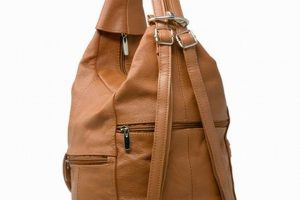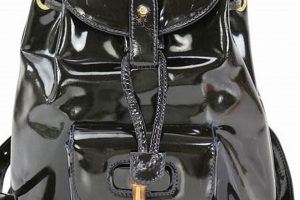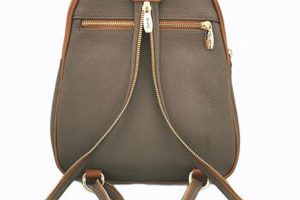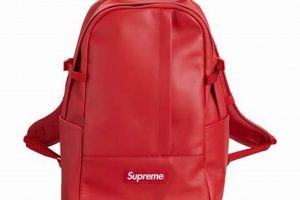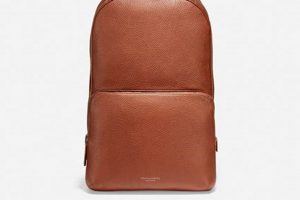A carrying case designed for transporting a laptop computer and related accessories, often constructed from tanned animal hide, combines functionality with a distinct aesthetic. These items typically feature padded compartments to protect electronic devices, along with additional pockets for organizing peripherals, documents, and personal belongings. Examples range from minimalist designs with clean lines to more elaborate models incorporating multiple external pockets and specialized organizational features.
The appeal of these bags lies in their durability, sophisticated appearance, and potential for long-term use. The material offers a degree of water resistance and, with proper care, can withstand the rigors of daily commutes and travel. Historically, the use of this material in bags signified quality and status, a perception that continues to influence consumer preference. The inherent longevity and aesthetic qualities contribute to a perceived value that extends beyond purely functional considerations.
The subsequent sections will delve into specific aspects of these items, including material grades and maintenance, design variations, security features, and factors to consider when selecting the most suitable option for individual needs.
Selection and Maintenance Guidance
The following guidelines are provided to assist in the appropriate selection and long-term care of these specialized carrying cases.
Tip 1: Evaluate Material Quality. The quality of the hide significantly impacts durability and appearance. Full-grain examples represent the highest grade, exhibiting natural markings and developing a richer patina over time. Top-grain represents a mid-tier choice, offering a balance of aesthetics and value. Bonded alternatives, composed of shredded remnants, are generally less durable and exhibit a less refined texture.
Tip 2: Assess Compartment Padding. Adequate padding within the laptop compartment is crucial for protecting electronic devices from impact. Verify the density and coverage of the padding, particularly in vulnerable areas such as corners and edges. A dedicated, suspended compartment provides enhanced protection by preventing direct contact with the bottom of the bag.
Tip 3: Scrutinize Stitching and Hardware. Examine the stitching for uniformity, tightness, and strength. Reinforcements at stress points, such as handle attachments and shoulder strap anchorages, indicate a higher level of construction quality. Opt for hardware crafted from durable materials such as brass or stainless steel to resist corrosion and wear.
Tip 4: Consider Organizational Features. Evaluate the number, size, and configuration of internal and external pockets. Prioritize features that accommodate specific needs, such as dedicated slots for tablets, smartphones, pens, and water bottles. A well-organized interior promotes efficiency and prevents damage to delicate items.
Tip 5: Implement Regular Cleaning Practices. Routine cleaning helps maintain the material’s appearance and prevents the accumulation of dirt and grime. Use a soft, damp cloth to gently wipe the exterior surface. For stubborn stains, employ a leather cleaner specifically formulated for the finish. Avoid harsh chemicals or abrasive materials that can damage the hide.
Tip 6: Apply Leather Conditioner Periodically. Regular conditioning helps replenish the natural oils in the material, preventing it from drying out and cracking. Apply a thin, even coat of leather conditioner every few months, following the manufacturer’s instructions. Allow the conditioner to penetrate the material fully before using the bag.
Tip 7: Store Properly When Not In Use. When not in use, store the bag in a cool, dry place away from direct sunlight and heat. Stuff the interior with acid-free paper or cloth to help maintain its shape. Avoid storing it in plastic bags, as they can trap moisture and promote the growth of mold or mildew.
Adherence to these guidelines promotes the longevity and preserves the aesthetic appeal of the item, ensuring its continued utility and value.
The following sections will provide a comprehensive overview of various design elements, security measures, and factors pertinent to individual selection criteria.
1. Material Grade
The grade of the hide employed in constructing a laptop carrying case substantially dictates its longevity, aesthetic qualities, and overall performance. Higher grades typically exhibit superior durability and develop a more desirable patina over time, while lower grades may be more susceptible to wear and exhibit a less refined appearance.
- Full-Grain Leather
Represents the highest quality grade, utilizing the entire grain layer of the hide. This material exhibits natural markings and possesses inherent strength. Bags crafted from this material tend to be more resistant to abrasions and develop a richer patina with age. The higher cost associated with full-grain is often justified by its durability and aesthetic appeal, making it a desirable choice for discerning consumers.
- Top-Grain Leather
This grade involves sanding away imperfections from the surface of the hide and applying a finish coat. While more uniform in appearance than full-grain, top-grain is generally less durable and may not develop the same rich patina. It represents a balance between quality and cost, offering a more accessible option for consumers seeking a premium aesthetic without the higher price point of full-grain.
- Genuine Leather
A mid-tier grade often encompassing splits from the hide. It is corrected to achieve a more uniform look, or imprinted with grain patterns. While economical, this alternative lacks the durability and resilience of higher quality leather grades.
- Bonded Leather
The lowest grade, comprising shredded scraps bonded together with adhesives. Bags constructed from this material typically exhibit reduced durability and a less desirable texture. While offering a lower price point, bonded leather is generally not recommended for applications requiring long-term durability or a premium aesthetic.
The choice of material grade directly impacts the lifespan, appearance, and cost of the carrying case. Consumers should carefully consider their individual needs and budget when selecting a bag, weighing the benefits of higher grades against the cost savings of lower grades. Ultimately, the material grade is a critical factor in determining the value and suitability of the item.
2. Compartment Protection
The integrity of a laptop carrying case is fundamentally tied to its ability to safeguard electronic devices from physical damage. The internal compartment specifically designed for housing the laptop is, therefore, a critical area of focus when evaluating its protective capabilities. Material composition, structural design, and supplementary features all contribute to the effectiveness of this crucial element.
- Padding Density and Composition
The density and type of padding material directly correlate with the degree of impact absorption. High-density foam, such as closed-cell polyethylene or memory foam, provides superior protection compared to open-cell foam or thin layers of fabric. The thickness and distribution of padding across the compartment, particularly at corners and along edges, are also crucial factors. For example, a case incorporating a 1/2-inch layer of high-density foam throughout the laptop compartment offers significantly better protection than a case with minimal padding.
- Suspended Laptop Design
A suspended laptop compartment elevates the device above the base of the carrying case, preventing direct contact with the ground during accidental drops. This design minimizes the transmission of impact forces to the laptop’s sensitive components. A common example involves a cradle-like structure with elastic straps that securely hold the laptop in place while maintaining a small air gap between the device and the bottom of the bag.
- Reinforced Edges and Corners
Edges and corners are particularly vulnerable to damage during impacts. Cases incorporating reinforced edges and corners, often through the use of additional padding, external bumpers, or rigid frames, provide enhanced protection in these critical areas. An example includes the use of molded plastic corner guards or additional layers of leather stitched along the perimeter of the compartment.
- Water Resistance Measures
While not directly related to impact protection, water resistance is an important factor in protecting electronic devices from environmental damage. Cases featuring water-resistant linings or coatings within the laptop compartment can prevent moisture from seeping in and damaging sensitive components. For example, a waterproof membrane laminated to the interior of the compartment provides a barrier against rain or accidental spills.
Collectively, these elements contribute to the overall protective capabilities of the laptop compartment, enhancing its ability to shield electronic devices from physical damage. A well-designed compartment incorporating these features significantly reduces the risk of damage during daily use, commuting, or travel. The synergy between the material construction and design of the leather carrying case provides durable protection.
3. Hardware Durability
The longevity and functionality of a carrying case are significantly influenced by the quality and resilience of its constituent hardware components. These elements, though often overlooked, play a crucial role in ensuring the bag’s structural integrity and ease of use. The selection of robust hardware is particularly vital in high-use items where wear and tear are expected over extended periods.
- Zippers
Zippers are primary closure mechanisms, subject to frequent use and stress. Opting for high-gauge metal zippers, such as those constructed from brass or stainless steel, enhances durability compared to plastic alternatives. Metal zippers resist breakage and maintain smooth operation over time. Reinforced stitching around the zipper track further reinforces its attachment to the case, minimizing the risk of separation under load. A poorly constructed zipper can render a bag unusable, highlighting the significance of this component.
- Buckles and Clasps
Buckles and clasps secure flaps, straps, and compartments. Metal buckles and clasps, particularly those made from solid brass or stainless steel, offer greater resistance to breakage and corrosion compared to plastic alternatives. Reinforced attachment points, such as rivets or bar-tack stitching, enhance the structural integrity of these components. A compromised buckle or clasp can compromise the security and functionality of the bag.
- Rivets and Reinforcements
Rivets and reinforcements are strategically placed at stress points, such as handle attachments and strap anchorages, to distribute load and prevent tearing. Solid metal rivets, properly installed, provide a secure and durable connection. Reinforced stitching patterns, such as bar-tack stitching, further enhance the strength of these attachment points. The absence of adequate reinforcement can lead to premature failure of these critical areas.
- Strap Adjusters and D-Rings
Strap adjusters and D-rings allow for customization of strap length and attachment of accessories. Metal adjusters and D-rings, particularly those made from heavy-gauge steel or brass, offer greater durability and resistance to bending or breakage compared to plastic alternatives. Smooth operation of the adjusters is essential for ease of use. Compromised adjusters or D-rings can limit the bag’s versatility and comfort.
The durability of the hardware components directly impacts the overall lifespan and functionality of the item. Investing in a case featuring high-quality hardware ensures that the bag can withstand the rigors of daily use and maintain its structural integrity over time. The synergy between the material construction and quality of hardware of the leather carrying case provides durable protection. Compromising on hardware quality can lead to premature failure and diminish the value of the investment.
4. Organizational Capacity
The organizational capacity of a leather computer backpack is a critical determinant of its functional utility. It dictates the efficiency with which various items can be stored, accessed, and protected within the bag, directly impacting the user experience.
- Dedicated Laptop Compartment
A designated padded compartment specifically designed to accommodate a laptop is paramount. This compartment should provide secure containment and impact protection for the device, preventing movement and potential damage during transit. Examples include compartments with adjustable straps or Velcro closures to secure the laptop in place, ensuring minimal shifting and safeguarding against scratches or impacts.
- Tablet/E-Reader Sleeve
The inclusion of a separate sleeve for a tablet or e-reader enhances organizational efficiency and prevents potential damage from abrasion against other items. This sleeve should be lined with a soft material to protect the screen and prevent scratches. Its presence allows for the segregation of delicate electronic devices, optimizing space utilization within the bag.
- Accessory Pockets and Dividers
The presence of multiple accessory pockets of varying sizes facilitates the organized storage of peripherals, documents, and personal items. Interior dividers further enhance organization by creating distinct sections for different categories of items. For instance, pockets designed for pens, business cards, smartphones, and charging cables contribute to a more efficient and streamlined user experience. The absence of such pockets can result in clutter and difficulty locating specific items.
- External Quick-Access Pockets
External quick-access pockets provide convenient storage for frequently used items, such as keys, wallets, or travel documents. These pockets should be easily accessible without requiring the user to open the main compartment of the bag. The design and placement of these pockets contribute to the overall convenience and efficiency of the backpack, enabling quick retrieval of essential items.
The effective integration of these organizational features significantly enhances the functional value of a leather computer backpack. It allows for the secure and organized transport of electronic devices and related accessories, contributing to a more efficient and productive workflow.
5. Aesthetic Appeal
The aesthetic appeal of a leather computer backpack significantly influences its perceived value and market positioning. Unlike purely utilitarian carrying solutions, these items often serve as an extension of personal style, reflecting an individual’s professional image and attention to detail. The use of tanned animal hide contributes to a perception of quality, durability, and sophistication, differentiating these bags from those constructed from synthetic materials. For instance, a sleek, minimalist backpack crafted from full-grain leather projects a different image compared to a utilitarian nylon bag, impacting how the user is perceived in professional settings and social contexts. The choice of color, hardware finish, and overall design further contribute to the aesthetic, allowing for a degree of personalization and self-expression.
The relationship between form and function is particularly important in the context of these carrying cases. While providing secure storage and protection for electronic devices, the design must also be visually appealing and aligned with current fashion trends or classic stylistic preferences. Manufacturers often offer a range of designs, from traditional styles with clean lines and understated hardware to more contemporary styles with bolder colors and distinctive features. The selection of a specific design reflects a conscious choice by the consumer, balancing practical needs with aesthetic considerations. The longevity of this aesthetic is also a consideration; a timeless design can extend the perceived value and lifespan of the item.
In conclusion, the aesthetic appeal is an intrinsic component influencing consumer choice and overall value perception. It represents a confluence of design elements, material quality, and personal expression. The success of this carrying solution relies on striking a balance between functionality and visual appeal, reflecting both the practical requirements of transporting technology and the user’s desire to project a specific image. Challenges arise in maintaining consistent quality and adapting to evolving aesthetic preferences, requiring ongoing innovation and attention to detail in both design and manufacturing processes.
6. Ergonomic Design
Ergonomic design, in the context of a leather computer backpack, directly impacts user comfort, posture, and long-term musculoskeletal health. The weight of a laptop and associated accessories, often substantial, necessitates a design that distributes this load evenly across the wearer’s back and shoulders. Poor ergonomic design can lead to back pain, neck strain, and shoulder discomfort, resulting in reduced productivity and potential long-term health issues. An example of effective ergonomic design includes adjustable shoulder straps that allow the wearer to customize the fit, ensuring the bag sits snugly against the back without excessive pressure on any single point. A padded back panel, contoured to the natural curvature of the spine, further enhances comfort and promotes proper posture. Conversely, a bag with thin, non-adjustable straps and a flat, unpadded back panel offers minimal ergonomic support, increasing the risk of discomfort and potential injury. The practical significance of understanding ergonomic principles in relation to these carrying cases lies in the ability to select a product that minimizes physical strain and promotes well-being during daily use.
Specific design features contribute significantly to the ergonomic performance of the backpack. A sternum strap, connecting the shoulder straps across the chest, helps to stabilize the load and prevent the straps from slipping off the shoulders. A waist belt, transferring some of the weight to the hips, further reduces strain on the back and shoulders. The positioning and adjustability of these straps are crucial for optimizing comfort and weight distribution. Furthermore, the internal organization of the bag can influence its ergonomic performance. Distributing weight evenly within the bag, rather than concentrating it in one area, helps to maintain balance and prevent uneven pressure on the back. For example, placing heavier items closer to the back, within the laptop compartment, and lighter items in outer pockets promotes a more balanced load distribution.
In summary, ergonomic design is an essential component of a leather computer backpack, directly influencing user comfort and long-term health. Key features such as adjustable straps, padded back panels, sternum straps, and waist belts contribute to optimal weight distribution and reduced strain. Selecting a bag with these ergonomic features is crucial for minimizing the risk of discomfort and potential injury. Challenges in this area involve balancing ergonomic considerations with aesthetic appeal and material costs, requiring manufacturers to prioritize user well-being while maintaining a desirable product design.
7. Weather Resistance
The capacity of a carrying case to withstand environmental elements is a significant factor in preserving the integrity of electronic devices and documents contained within. While tanned animal hide possesses inherent protective qualities, its interaction with moisture and temperature fluctuations necessitates a nuanced understanding of weather resistance. The implementation of specific design features and treatment processes enhances this critical aspect.
- Natural Water Resistance of Leather
Tanned animal hide, by its nature, exhibits a degree of water resistance due to the inherent oils and tightly woven fibers. This inherent property, however, is not absolute, and prolonged exposure to moisture can result in saturation, leading to warping, staining, and potential damage to the material. The type of tanning process employed also influences the water resistance, with certain methods imparting greater resilience than others. For example, vegetable-tanned hide tends to be more susceptible to water damage compared to chrome-tanned hide, which undergoes a chemical process that enhances its water-repellent properties.
- Surface Treatments and Coatings
To augment the natural water resistance, manufacturers often apply surface treatments or coatings to the hide. These treatments, typically consisting of waxes, silicones, or synthetic polymers, create a barrier that repels water and prevents it from penetrating the material. The effectiveness of these treatments varies depending on the specific formulation and application method. Regular reapplication of these treatments is often necessary to maintain their protective properties. Examples of these treatments include the application of beeswax-based conditioners or silicone-based sprays, which form a hydrophobic layer on the surface of the hide.
- Seam Sealing and Construction Techniques
The construction techniques employed in assembling the carrying case play a crucial role in preventing water intrusion. Sewn seams represent potential points of water entry, necessitating the use of seam-sealing techniques to create a waterproof barrier. These techniques involve applying a sealant or tape to the seams, preventing water from seeping through the needle holes. Additionally, the design of closures, such as zippers and flaps, influences the overall weather resistance. Overlapping flaps and water-resistant zippers minimize the exposure of the bag’s contents to the elements. For instance, a carrying case featuring taped seams and a storm flap covering the zipper provides enhanced protection against rain and moisture.
- Lining Materials and Internal Protection
The materials used for the lining of the carrying case contribute to the overall protection of electronic devices and documents. Water-resistant linings, such as nylon or polyester, provide an additional barrier against moisture intrusion. Padded compartments designed to hold laptops and tablets often incorporate these water-resistant linings to safeguard sensitive electronic components. The presence of these linings can mitigate the effects of water damage, even if the exterior of the bag becomes saturated. For example, a carrying case with a waterproof nylon lining within the laptop compartment offers a degree of protection against accidental spills or exposure to rain.
The convergence of these facets, encompassing both the inherent properties of tanned animal hide and the implementation of specific design features and treatment processes, determines the overall weather resistance of the carrying case. Understanding these elements enables informed decision-making regarding product selection and maintenance, ensuring the preservation of valuable electronic devices and documents in diverse environmental conditions.
Frequently Asked Questions
This section addresses common inquiries and concerns regarding leather computer backpacks, providing factual information to assist in informed decision-making.
Question 1: What distinguishes full-grain leather from other leather grades in backpacks?
Full-grain leather, derived from the uppermost layer of the hide, retains its natural grain and possesses the highest durability. Other grades, such as top-grain or bonded leather, undergo processing that diminishes their strength and alters their appearance.
Question 2: How should one properly maintain a leather computer backpack to ensure its longevity?
Regular cleaning with a damp cloth and periodic application of leather conditioner are crucial. Avoid exposure to excessive moisture and direct sunlight. Store in a cool, dry place when not in use.
Question 3: Are leather computer backpacks suitable for individuals with heavy laptop carrying needs?
The suitability depends on the bag’s construction and ergonomic design. Seek models with reinforced stitching, padded straps, and a weight-distributing frame to accommodate heavier loads.
Question 4: What are the primary security considerations for a leather computer backpack?
Prioritize features such as lockable zippers, hidden compartments, and slash-resistant materials to deter theft. Be mindful of surroundings in crowded areas.
Question 5: Can the natural leather of a backpack be effectively protected from rain?
While leather possesses some inherent water resistance, additional protection is advisable. Apply a leather protectant spray or wax to enhance water repellency.
Question 6: Does the color of a leather computer backpack affect its durability or maintenance requirements?
Color primarily affects aesthetic considerations. However, lighter colors may show stains more readily than darker colors, requiring more frequent cleaning.
In summation, the material grade, care regimen, and security considerations are pivotal aspects of leather computer backpacks. Understanding these elements facilitates the selection and preservation of a suitable item.
The following section will explore practical scenarios for integrating leather computer backpacks into diverse professional environments.
Conclusion
The preceding sections have illuminated the multifaceted attributes inherent within a leather computer backpack. From material grades and protective features to ergonomic considerations and aesthetic dimensions, this exploration has underscored the complex interplay of factors influencing its utility and overall value. Understanding these elements empowers consumers to make informed decisions aligned with their specific needs and professional requirements.
The modern professional landscape demands a seamless integration of functionality and style. As technology becomes increasingly integral to daily workflows, the selection of appropriate carrying solutions warrants careful consideration. A leather computer backpack, when chosen judiciously, represents not merely a means of transporting equipment, but a statement of professional competence and a commitment to enduring quality. The enduring appeal lies in the balance of protection, style, and organizational capacity, solidifying its place in the executive marketplace.


